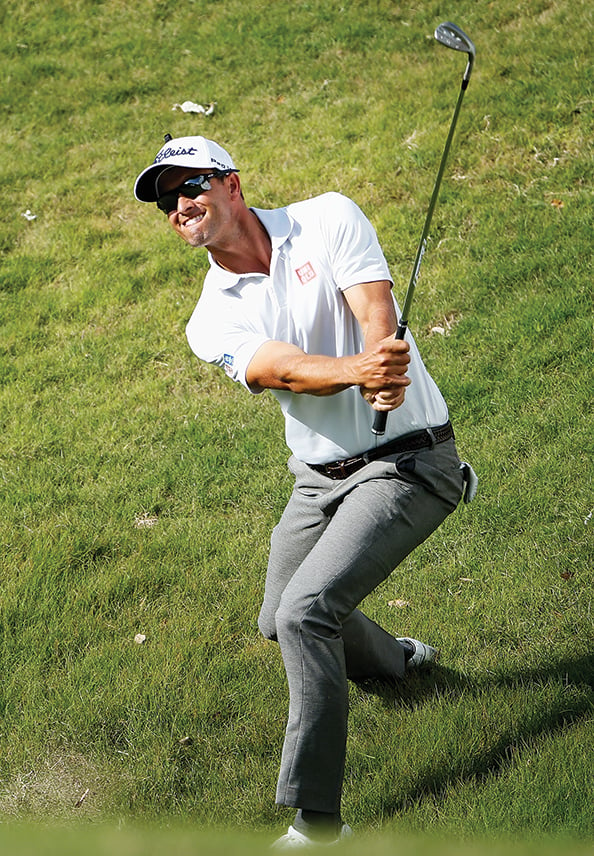How I prepare for Augusta National can help you slice your handicap in no time. By 2013 Masters champion Adam Scott
IT’S that time of the year when preparation for a golf tournament doesn’t get any more important. I’ve said it before, but going to the first tee on Thursday at Augusta National is the most nervous I get all year, of any event, anywhere, at any time. Even more nervous than coming to a playoff or coming off the last hole with a chance to win, is the first tee at Augusta National. It’s for that reason I need to be 100 per cent prepared with all facets of my game to ensure I have the confidence to handle the nerves, just as you should for your major club tournaments throughout the year.
To help you with that, I’ve picked a few shots I focus on each year for the Masters that I believe can lower your scores significantly if added to your practice routine. Execute these and you may not win a green jacket, but you’ll be well on your way to better golf.
Practise On Uneven Lies
There’s so much undulation in the fairways at Augusta that you rarely get a flat lie. You’ve got to get your body set to the slope – that’s the most important thing. A great exercise I like to do – which you can do at your local golf club – is hit some balls off the side of the range where there are different slopes, not just flat, manicured grass. Feeling comfortable on varying slopes is what I like to practise before I tee up a ball at the Masters. It can help you too, because you never know what kind of lie you’re going to get. Even the flattest courses in the world can present an uneven stance on any given day. The secret is being prepared.

Control The Short Pitch
At Augusta, you’ve got to be dialled in from 50 to 70 metres, especially on the par 5s like holes 13 and 15, where on tough days laying up is the smartest option. If you leave yourself 50-70m and you’re sharp at that range, there’s a good chance you’re making birdies – and we all want them, right? These are the holes you can take advantage of.

At that distance, there shouldn’t be too much difference in what I practise and what you practise. The closer we get to the hole, the more relevant it is for amateurs to look at what the pros are doing. The 70-metre wedge shot should be a shorter, compact swing with a nice rotation back and through [see my follow-through here?]
Rhythm is very important at this range as it helps square the clubface, but rotation is also key as it leaves the true loft on the club. Those two factors are really important at Augusta because it’s crucial to control both the flight and spin. When you start using your hands it’s very easy to manipulate the clubface and that leads to inconsistency. Jason Day does an amazing job of minimising his wrist hinge for consistency, as do all players out here on tour, really.
So remember the two Rs – Rhythm and Rotation. Practise this and you’ll start leaving yourself short birdie putts.
Master The Breaking Putt
 This is a very obvious area to practise before Augusta but one thing I specifically focus on is short, breaking putts – or, in Augusta’s case, severely breaking putts. Putts break at Augusta more than anywhere else we visit on tour. Anywhere from 10 feet and in you have to get used to aiming well away from the edge of the cup. To put that in perspective, anywhere else on tour, from 10 feet in, you might play it a cup outside or a big break is two cups out. At Augusta, you might play it three feet out! What you can learn here is to not get distracted looking at the hole and accidentally pull it back online – trust your initial read and execute that putt.
This is a very obvious area to practise before Augusta but one thing I specifically focus on is short, breaking putts – or, in Augusta’s case, severely breaking putts. Putts break at Augusta more than anywhere else we visit on tour. Anywhere from 10 feet and in you have to get used to aiming well away from the edge of the cup. To put that in perspective, anywhere else on tour, from 10 feet in, you might play it a cup outside or a big break is two cups out. At Augusta, you might play it three feet out! What you can learn here is to not get distracted looking at the hole and accidentally pull it back online – trust your initial read and execute that putt.
If you’re missing a lot of breaking putts from close range, work on your aim point. By that I mean read the break and then pick a spot, or target [above], on the green where you wish to roll your ball to in order to allow for that break. Stay focused on that point and don’t look back at the hole. If you’ve read the break correctly, you will hit more consistent putts and ultimately lower your score.

– with Evin Priest



